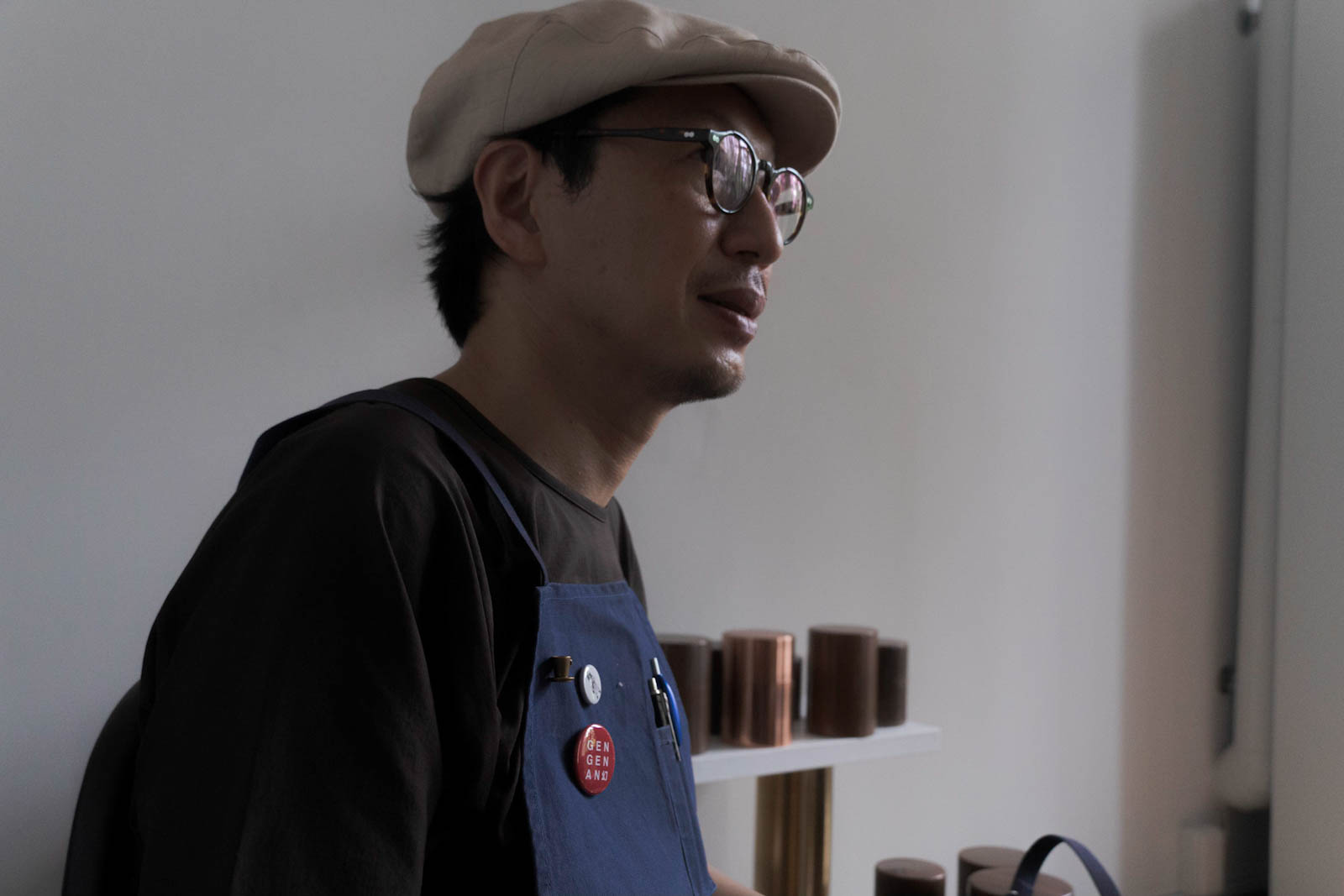
Q. Kaikado is known as a long-established company in Kyoto with 140 years of history. What was the reason why Kaikado, continuously making tea caddies for many years, decided to open a café?
In fact, the former president of Kaikado (the current 5th chairman) was an unparalleled coffee lover and had always dreamed of opening a coffee shop after he retired. Another reason was the desire to open a café that would be a gateway into the craft, including tea caddies. We had been making coffee utensils for Nakagawa Wani Coffee with craftsmen in Kyoto, including Kaikado. I thought that a café could create a place where young people and people who have not had the opportunity to use crafts on a daily basis could easily touch them.
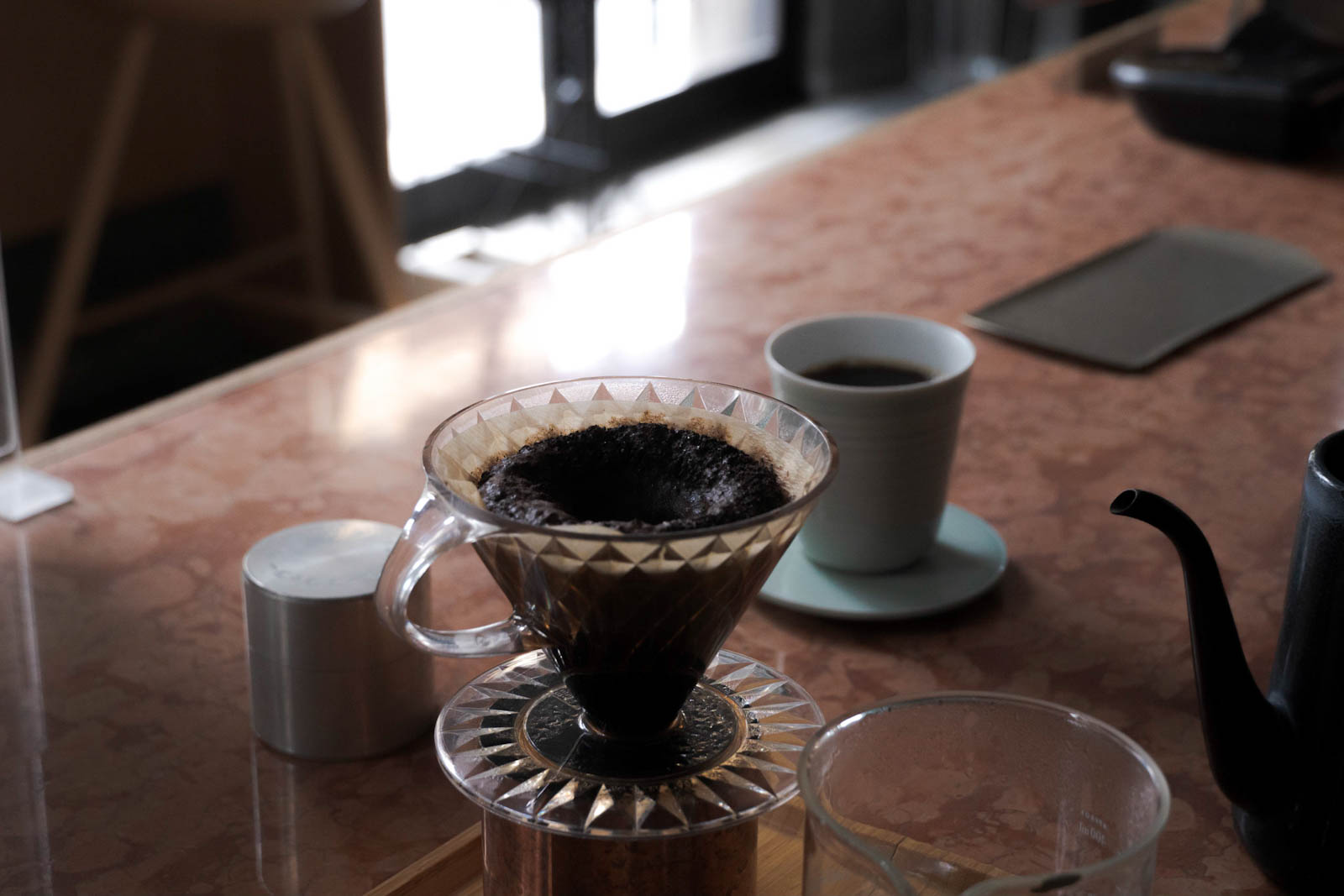
Q. Kaikado Café's coffee is handed down from Wani Nakagawa, isn't it? What kind of guidance did you receive from Nakagawa?
As I learnt from Mr.WANI, I realized that coffee is always different from day to day and cannot be quantified. The freshness of the beans also changes on each day, as well as many other factors, such as the slight difference in water temperature and humidity of the day. He often says, "When you make coffee, you should look at the situation that is happening right here and now. Also he points out, "When you make coffee, you should look at the situation that is happening right here and now. I am learning to understand the expression of the foam and the aroma of the coffee, so that I can always brew the best coffee at that moment.

Q. Isn't it quite difficult to learn something sensible that is not simply numerical or time-based?
Well, in my case, as I've been a coffee lover for a long time, I've been trying to learn things on my own, and I've had a lot of weird habits caused by all this extra knowledge. If I had learnt to brew from the basics, I would have been able to do it straight away, but I'm a bit of a stickler and my habits get in the way, and the busier I am with customers, the more my bad habits come out. At first, I had serious problems with this habit.
There are currently a total of nine staff、 but only three of them are able to brew coffee and serve it to customers. Some staff are in training. They can brew well under the comfort of the situation and no one is watching, however once they feel nervous in front of customers, or even in a hurry due to lots of orders, they fail to do due to compliance with routine.. Coffee is very sensitive to these small differences. We are continuously focusing on those subtle slight differences.

Q. As you learn about making coffee every day in this way, is it really different from the coffee you make before?
Definitely, it is changing. In the beginning, there were a lot of different flavors, some of which were unnecessary to get out, some of bitterness and unpleasantness, but now I feel that it is gradually reduced. Even now, every three months, I'm still being instructed by Mr.WANI, he still says, "Hmmm, not quite..." when I ask him to do a tasting. Strangely, when someone makes the coffee, I can notice the slight difference, but in the case of my own coffee, it's hard for me to detect the difference because I taste it every day.
I've been doing this job for six years, however it's really difficult to keep it in a stable condition. I'm not proud enough to say that I've scored 100 yet, but I think I've grown to be able to notice for myself where I made mistakes in certain areas. It is interesting that even if I brew a coffee perfectly, the feeling of satisfaction only lasts for a moment, and the next moment I wonder if I could have brewed a better coffee if I had noticed something else.
For example, if we quantified the coffee, and left it to machines doing exactly the same taste, it might be able to score a 100 every time. But the reason why we persist with hand drip is that we human beings make the coffee, so naturally there will be mistakes, but we could aim for a 120-point taste, which machines can't do. But this is the best part of brewing coffee. The reason why I can continue to deal with such a nervous feeling every day, "Next time I will brew a cup of more tasty coffee! " This might be a motivation to keep going.

Q. What kind of coffee is Kaikado Café aiming for?
There are lots of cafés and coffee shops, but most of them offer 'single origin', single cultivar, trying to properly convey the unique flavor characteristics of the bean. In contrast, we just operate with only one type of blended coffee. The taste is based on what I mentioned before, the most favorite taste of my predecessor, who wanted to open a coffee shop. We want to serve what we think is the right taste at Kaikado Cafe, not what is popular currently. It took about four months to decide on that flavor. In creating the blend, I tried many different flavors, had the chairman taste them and decided on the one that he liked the best. That is the only blend of coffee we are offering now.
This is the sixth year, and we asked Mr.WANI to come up with a new blend to further brush up the taste for the next decade, and to create something new but unique to Kaikado. We started tasting with staff in February last year and switched to the new blend in last April.
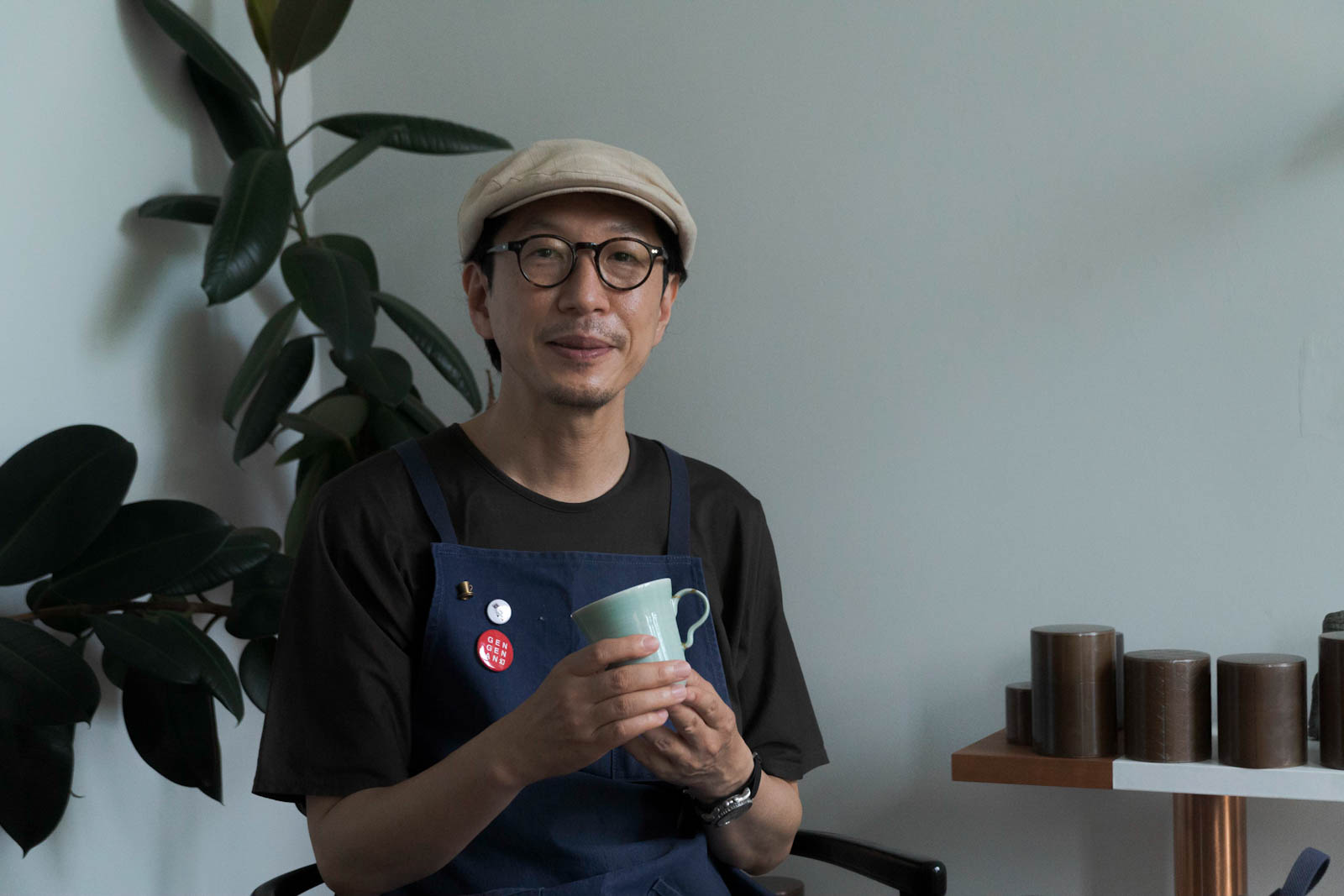
Q. Could you describe what the Chairman's coffee preferences are?
As brewers, we are conscious of coffee that is not excessively punchy or bitter in taste, but is smooth and easy to drink, with a slight sense of depth in the middle of the aroma and flavour, that can be drunk without conscious thought.
When I finish the coffee and leave the shop, crossing the Shichijo intersection, I think, 'Hmm, I'd like to drink it again'.
Our coffee is neither shallow-roasted nor deep-roasted, but medium-roasted, and many people who do not like coffee say that after the first sip, their impression of the coffee has changed and they can drink it black.
While some young people like coffee, there are many who don't like coffee. One of our young student customers said, "I couldn't drink coffee, but now I like coffee here." I was so happy to hear that, "This is what we are aiming for".
Q. It takes a lot of courage to change a finished blend, doesn't it?
Yes, it is not just a matter of putting the beans in the machine and roasting them, there is a certain process. Blending is a particularly important part to determine the taste of the coffee.
First, we divide them into three main taste trends, then narrow them down and sort into groups according to the Chairman's favourite tastes, and from there we create several more blends.
The previous flavor featured an earthy taste, whereas the current one gives the impression of being a little more woody, with a woody flavor at its core. However, although the new blend has indeed completely changed the beans and the blend, the basic taste has not changed as much in terms of the Chairman's preferences.
I notice the difference between the two if I compare them, but if a customer came to the cafe a year ago, maybe they wouldn't even notice it. Slightly changed? However, the taste has not taken a completely different direction, and it is absolutely Kaikado's taste. Our coffee is not about what kind of beans we use, but about the taste of Kaikado Cafe, which we want to preserve for a long time.

①
To extract a clean, full-flavoured taste, use plenty of beans at 30g per cup.
②
It's like putting a little hot water on the dripper at the beginning, for example, like a 10 yen coin or a 100 yen coin.
③
It depends on the state of the coffee at the time.If the coffee contains gas, it will puff up into a semi-circle, if the beans have been ground for a long time, they will be dented, and various other situations may occur. Based on the situation, we judge whether it's freshly roasted or a bit older, and then we think about how we want to brew it next.
④
Then, if you pour the hot water, reached around 92-95°C, into the coffee, the hot water and beans in the room temperature will not blend well together. Also, if you pour too much hot water into the coffee, the hot water will get out before absorbing as it contains oil.
⑤
After that, gradually add hot water for the second and third pitches. If too much water is poured, it will become waterlogged and will not penetrate、 so pour it little by little while checking.
⑥
Then the reaction changes、 there is a moment when the coffee flutters to the top. That's a sign that it can accept a bit more hot water、 and then you add a bit more hot water.
⑦
When hot water is added in the middle, a fluffy bubble will appear on the return, and when it does, the bubble is moved. Repeat this process for the first half of the brew and the base of the flavor will be built up in the dripper.
⑧
Afterwards, the water will gradually start to drop from the bottom and the mixture will start to clump up, so you can then increase the amount of hot water to push the extract of flavors inside to the bottom.
If you turn the pot at that time, you will step on the top with the hot water you are filling it with, so pour the hot water in the middle properly, pour the hot water as if you were moving it up and down, and repeat the action to bring it back up with a final snap. Repeat this until you have taken the required amount of hot water and you are done. Once the required amount is taken, stop there, even if there is still hot water left.
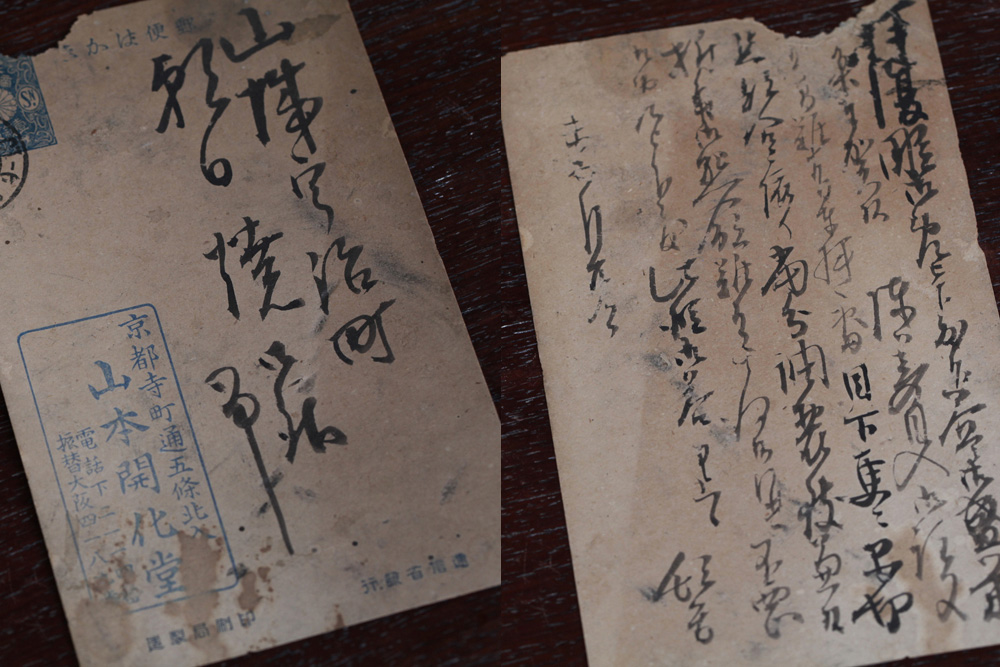
Old postcard that is believed to date from the Meiji era. Testimony to the exchange between Kaikado and Asahiyaki since that time.
Q. In the Kaikado Café , Asahiyaki cups are used, aren't they?
Yes, we currently use three types of cups: coffee , tea and cups and saucers for café au lait. Kaikado Cafe is called a 'café', but I think the roles of the café are the space, the atmosphere and many other elements. For us at Kaikado Café, 'the main actor' is our customer. In that sense, coffee plays a 'supporting role', we believe that the main role comes alive only when there is a good supporting role. The "props" that make the story (the customer's time) more mellow and memorable are the architecture, the interior and these cups.
In some cases, the cup is the leading role in the world. I also love cups and collect them, but the ones I end up using all the time are the ones I like unconsciously, such as my preference for mouthfeel and so on. In that sense, this Asahiyaki cup is not particularly outstanding as a cup to serve in a shop, it is simple and not showy, but it is a design that is very close to the coffee drinker, or it is a design that is very comfortable to enjoy the coffee.
I particularly love the smoothness of the mouthpiece and the easy way of holding it. It has a simple handle, but it is solid and secure. It is also nice to have a little device that prevents heat from being transferred to your fingers. This cup is not perfectly round, oval when viewed from above. This is the result of the emphasis on mouth feeling, but the craftsman went to great lengths to create this subtle oval, even though he could have made a beautiful circle.
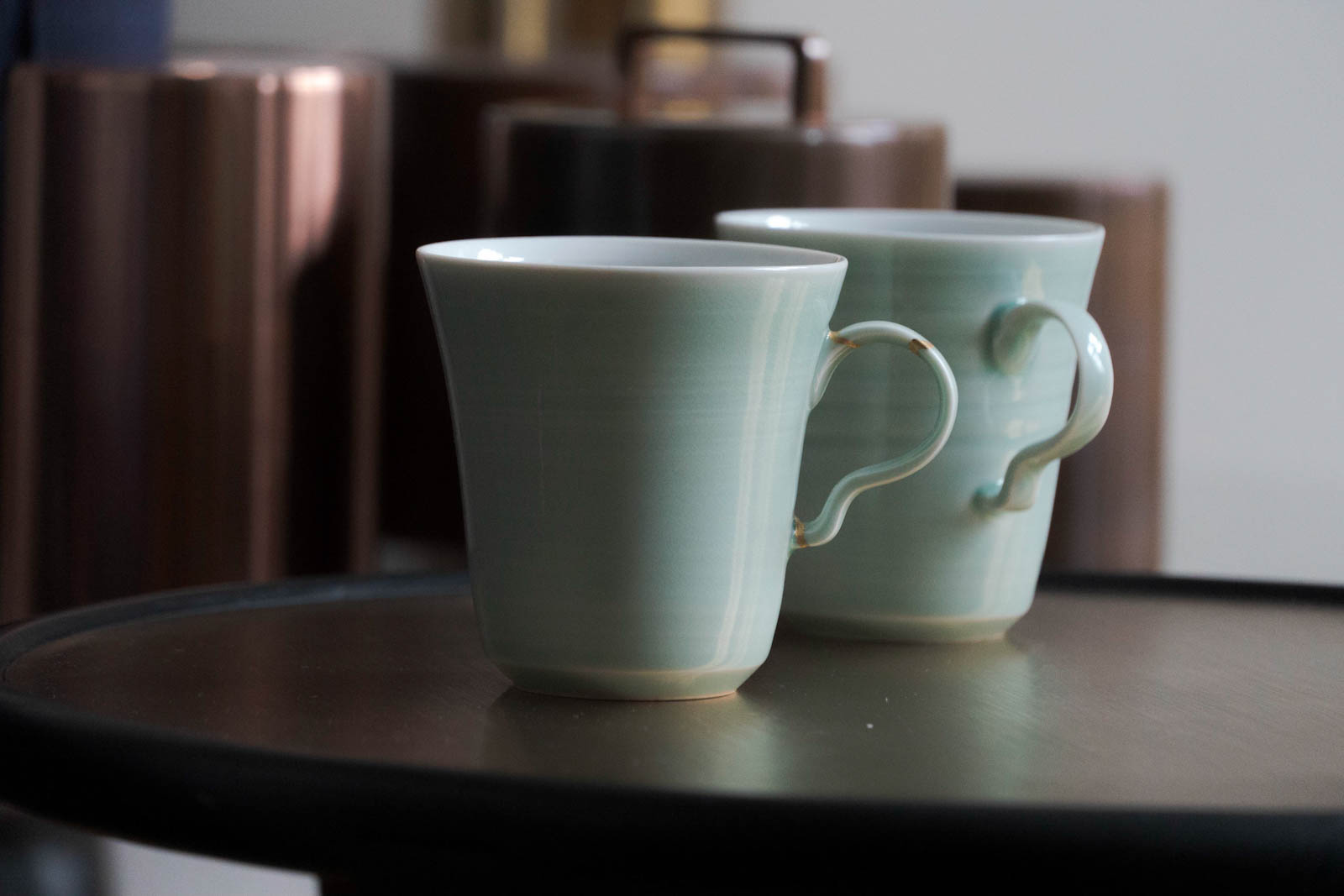
This design concept was conceived by Mr.WANI to suit the Japanese palate. Based on this idea the shape was created when Mr. Matsubayashi visited Mr.WANI at his house. Sometimes coffee drips when you take your mouth off the cup, but this rarely happens with this cup! This thinness is also an important factor when it comes to mouthfeel. It is not too thin or, conversely, too bland and has a very good mouthfeel.
As for the color, we had the inside white porcelain and the outside celadon. It reflects the coffee beautifully, and in the same way that I mentioned the taste of our coffee earlier, it's like, "This cup has a nice mouthfeel and the design is simple, it's a good cup." I think the cups are designed in a way that people will remember them later.
It's the same as a tea canister etc. - a tool that is pleasant to use. You don't notice it when you are using it, but you notice it later, as you remember it. We believe that the coffee and the cup are an integral part of the relationship, as they are the elements that make our coffee taste better than when we drink it, and that we will remember it later in our memories. The feeling to go back for another cup of coffee, the way the coffee tastes on the mouth, the feel of the cup in your hand, the warmth, the texture of the celadon porcelain sinking into your heart. It is not only a taste sensation, but something felt with all five senses.
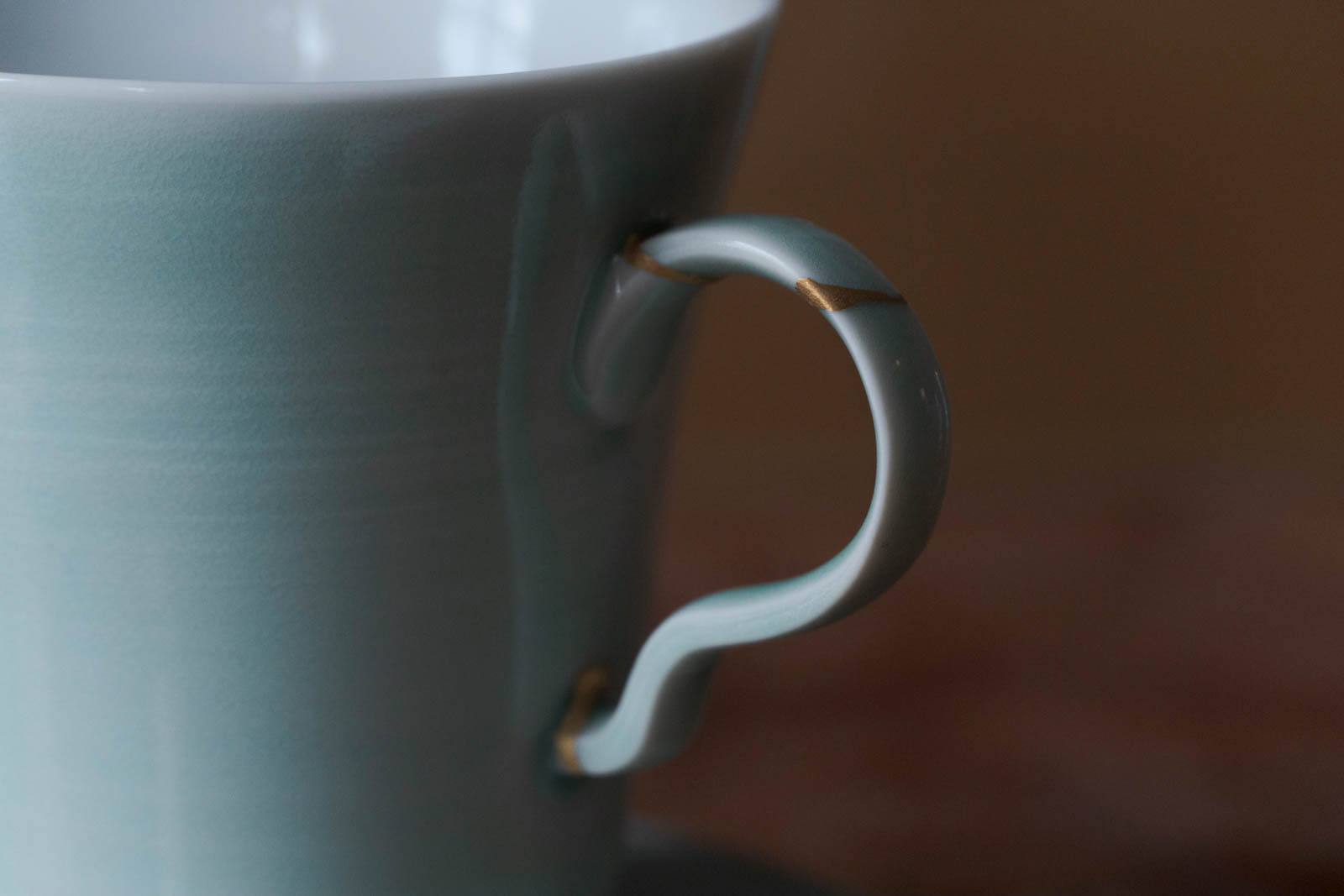
I heard that Kaikado's tea caddies are also handmade with the intention that they are tools for daily use and that they can be repaired and kept in use even if they break. Some of the Asahiyaki cups, also used at Kaikado Café, have been partially kintsugi(gilt-jointed), haven't they?
It's true. As a tool to be used in the shop, I would hesitate to buy something fragile. Personally, I have always loved pottery and vessels, and the first thing I begged my parents to buy me when I was in kindergarten was a vase for a single flower. From the time I was little, I was bought pottery, but maybe used roughly and inevitably chip or break. The coffee cups my parents had were also gradually reduced because of me.
But after joining Kaikado, I realized that even if something is broken, it should be repaired and used. I also learnt that, like kintsugi ( gold-jointing ), not only can you fix and continue to use the piece, but a new charm is created there as well. It's a relationship between people and tools that is more affectionate. As the utensils are used every day in the shop, they inevitably chip as they are used. But that doesn't mean we want to throw them away and buy new ones, or replace them with ones that won't break. The Kaikado style is not only about the taste of the coffee, but also about the cups used to drink it.
A customer said to me before, "Only this cup is pretty with gold in this part". I will tell him about kintsugi, or the fact that even if it chips, it can be repaired and used again.We hope to convey the spirit of Kaikado, as well as a little bit about continuing to use tools while repairing them.
Depending on the vessel, the material used for the joint can be gold, copper or silver. It is also part of the fun to think about how to change the broken pieces.Instead of being discouraged because of breakages, I would turn it into an enjoyment to love my tools more. This is something really meaningful.
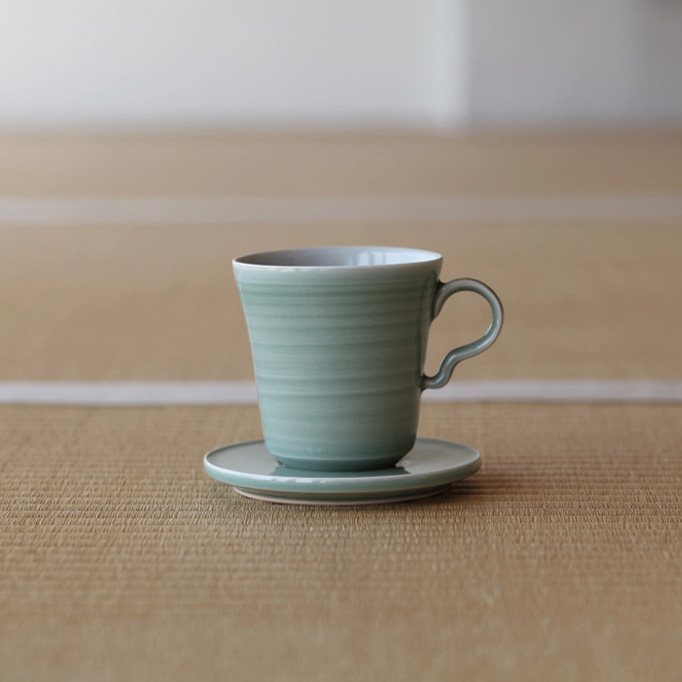
Price 14,300yen (tax included)
Kaikado café original cup designed by Wani Nakagawa. The current shape was decided after repeated prototyping to ensure the smoothness to handle and mouth-feel when drinking coffee. This cup and saucer is fully designed for drinking coffee in a delicious way.
Cup
Size Φ75×h68 mm (excluding handle)
Capacity 160 ml
Material Porcelain
Glaze Celadon
Firing Gas kiln

Price 28,600yen (tax included)
Kaikado café original cup designed by Wani Nakagawa. The current shape was decided after repeated prototyping to ensure the smoothness to handle and mouth-feel when drinking coffee. This cup and saucer is fully designed for drinking coffee in a delicious way.
Cup
Size Φ75×h68 mm (excluding handle)
Capacity 160 ml
Material Porcelain
Glaze Celadon,Shinsya
Firing Gas kiln
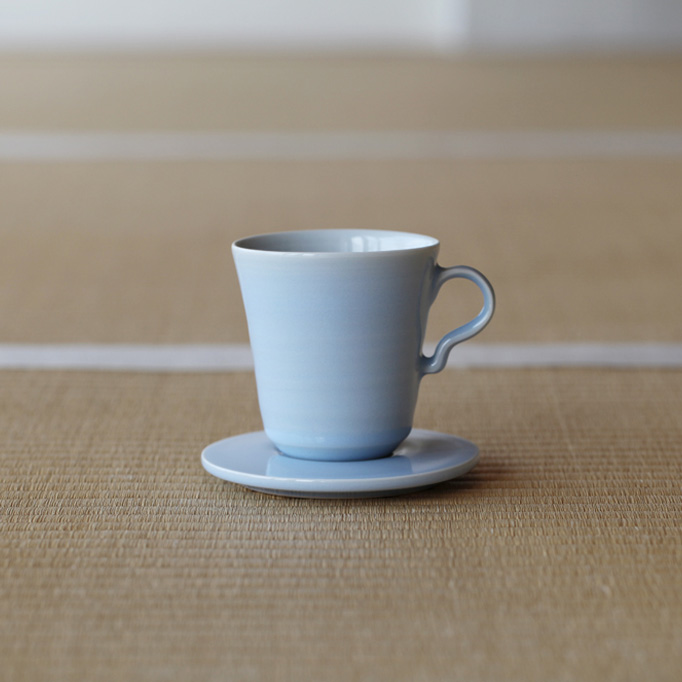
Price 14,300yen (tax included)
Kaikado café original cup designed by Wani Nakagawa. The current shape was decided after repeated prototyping to ensure the smoothness to handle and mouth-feel when drinking coffee. This cup and saucer is filled with designs to make coffee drink delicious and pleasure.
Cup
Size Φ75×h68 mm (excluding handle)
Capacity 160 ml
Material Porcelain
Glaze Celadon
Firing Gas kiln